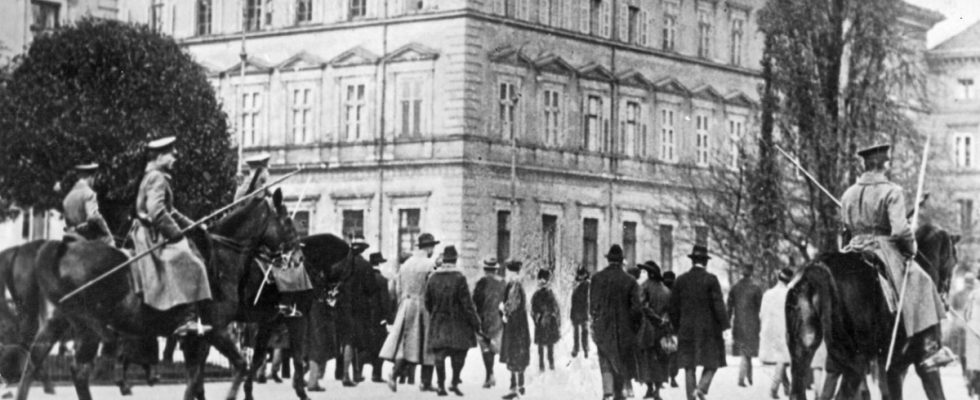Who fired the first shot on November 9th 100 years ago during the National Socialists’ march in front of Munich’s Feldherrnhalle, during the so-called Hitler Putsch, could not be clarified later. Not even Michael von Godin was able to contribute anything to the identification, although the shooter was only “one step to the left of me,” as he stated in his mission report the next day.
Michael Paul Ludwig Richard Freiherr von Godin, then 27 years old, was a first lieutenant in the Bavarian State Police and platoon leader of the unit that opposed the approximately 2,000 men led by Adolf Hitler and World War II general Erich Ludendorff who wanted to overthrow the Reich government in Berlin from Munich . The putschists had set off from the Bürgerbräukeller in Haidhausen around midday, marched over the Ludwigsbrücke into the valley and on to Marienplatz and were now on their way to the military district command, today’s state library, which SA men had occupied during the night.
At the Feldherrnhalle, Hitler’s troops met units of the state police, around 130 men. Godin had orders not to let the putschists through to Odeonsplatz under any circumstances. Godin later wrote in his statement, which is kept in the main state archives, that Hitler’s supporters advanced “with the bayonet felled and the safety lever unlocked and pistols pointed,” in short: “with war material of all kinds.” He himself initially tried to stop them with a carbine held “across the way” before the first shot was fired. It whizzed past his head and hit Sergeant Nikolaus Hollweg, who was standing behind him.
Without waiting for an order, the police then opened fire. There was a shootout that lasted less than a minute before Hitler’s people ran away, as Godin noted the next day. The coup had therefore failed. 13 rioters died at the Feldherrnhalle, as well as an uninvolved passerby and four police officers. In addition to Hollweg, Captain Rudolf Schraut, senior sergeant Friedrich Fink and assistant sergeant Max Schoberth.
The police are holding a memorial service on Residenzstrasse
This Thursday, the Munich police will commemorate the officers who were killed at the time, initially at 1 p.m. – the time of the exchange of fire – at an internal event in the headquarters on Ettstrasse. Later, at 2 p.m., a small memorial service with wreath-laying will take place at the scene of the incident on Residenzstrasse. There, only a rather inconspicuous plaque commemorates the men who gave their lives defending democracy.
The former police officer Walter Nickmann has studied this period intensively; he was part of the working group that curated an exhibition in 2012 on the role of the Munich police during National Socialism. Even today, as a pensioner, he gives lectures about it to young police officers, but also at the Nazi Documentation Center. Nickmann says: “The coup could only be put down by the state police, by closed, barracked units.” According to Nickmann, the city police with their individual officers were not in a position to do this organizationally. In addition, on that November night in 1923, she was under the influence of the putschists, at least briefly.
Because Munich’s police chief Karl Mantel, a staunch opponent of the National Socialists, was held hostage with his closest colleagues in the Bürgerbräukeller on the evening of November 8th, Wilhelm Frick, head of the political police and Hitler supporter, already imagined himself to be the new police chief had been informed about the alleged success of the coup.
While the takeover of power begins on the first floor, countermeasures are being planned
While Frick was still preparing everything for the takeover of power on the first floor of the building on Ettstrasse, the state police, which were located on the second floor and were subordinate to the Ministry of the Interior, were already taking countermeasures to thwart Hitler’s intentions. Frick was arrested that night, and Ernst Pöhner, who the putschists had intended to be Bavaria’s Prime Minister, was arrested in the early hours of the morning. Pöhner had been Munich’s police chief from 1919 to 1921 and had pushed his people strongly to the right.
Ten years later, after the successful seizure of power, the Nazis tried to take revenge on Godin. In May 1933 they put him in so-called protective custody in the Dachau concentration camp. After he was released in January 1934, he first fled to Austria and later to Switzerland. After the end of the war, he returned to Munich in June 1945, where he was appointed President of the Bavarian State Police. The man who led the men who opposed Hitler in 1923 continued to head the agency until 1959.

